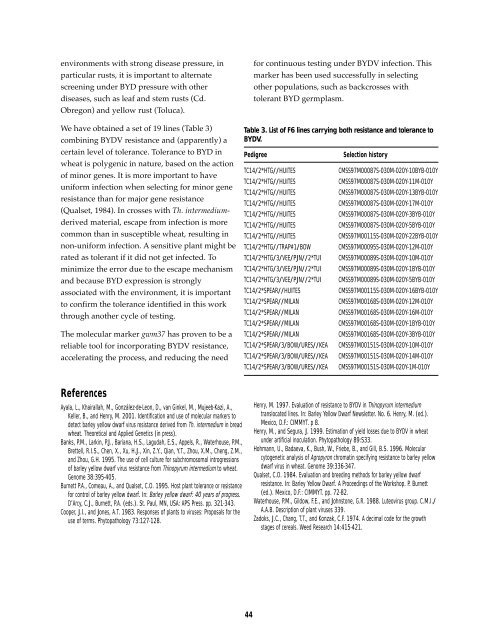Research Highlights of the CIMMYT Wheat Program 1999-2000
Research Highlights of the CIMMYT Wheat Program 1999-2000
Research Highlights of the CIMMYT Wheat Program 1999-2000
You also want an ePaper? Increase the reach of your titles
YUMPU automatically turns print PDFs into web optimized ePapers that Google loves.
environments with strong disease pressure, in<br />
particular rusts, it is important to alternate<br />
screening under BYD pressure with o<strong>the</strong>r<br />
diseases, such as leaf and stem rusts (Cd.<br />
Obregon) and yellow rust (Toluca).<br />
We have obtained a set <strong>of</strong> 19 lines (Table 3)<br />
combining BYDV resistance and (apparently) a<br />
certain level <strong>of</strong> tolerance. Tolerance to BYD in<br />
wheat is polygenic in nature, based on <strong>the</strong> action<br />
<strong>of</strong> minor genes. It is more important to have<br />
uniform infection when selecting for minor gene<br />
resistance than for major gene resistance<br />
(Qualset, 1984). In crosses with Th. intermediumderived<br />
material, escape from infection is more<br />
common than in susceptible wheat, resulting in<br />
non-uniform infection. A sensitive plant might be<br />
rated as tolerant if it did not get infected. To<br />
minimize <strong>the</strong> error due to <strong>the</strong> escape mechanism<br />
and because BYD expression is strongly<br />
associated with <strong>the</strong> environment, it is important<br />
to confirm <strong>the</strong> tolerance identified in this work<br />
through ano<strong>the</strong>r cycle <strong>of</strong> testing.<br />
The molecular marker gwm37 has proven to be a<br />
reliable tool for incorporating BYDV resistance,<br />
accelerating <strong>the</strong> process, and reducing <strong>the</strong> need<br />
for continuous testing under BYDV infection. This<br />
marker has been used successfully in selecting<br />
o<strong>the</strong>r populations, such as backcrosses with<br />
tolerant BYD germplasm.<br />
Table 3. List <strong>of</strong> F6 lines carrying both resistance and tolerance to<br />
BYDV.<br />
Pedigree<br />
TC14/2*HTG//HUITES<br />
TC14/2*HTG//HUITES<br />
TC14/2*HTG//HUITES<br />
TC14/2*HTG//HUITES<br />
TC14/2*HTG//HUITES<br />
TC14/2*HTG//HUITES<br />
TC14/2*HTG//HUITES<br />
TC14/2*HTG//TRAP#1/BOW<br />
TC14/2*HTG/3/VEE/PJN//2*TUI<br />
TC14/2*HTG/3/VEE/PJN//2*TUI<br />
TC14/2*HTG/3/VEE/PJN//2*TUI<br />
TC14/2*SPEAR//HUITES<br />
TC14/2*SPEAR//MILAN<br />
TC14/2*SPEAR//MILAN<br />
TC14/2*SPEAR//MILAN<br />
TC14/2*SPEAR//MILAN<br />
TC14/2*SPEAR/3/BOW/URES//KEA<br />
TC14/2*SPEAR/3/BOW/URES//KEA<br />
TC14/2*SPEAR/3/BOW/URES//KEA<br />
Selection history<br />
CMSS97M00087S-030M-020Y-10BYB-010Y<br />
CMSS97M00087S-030M-020Y-11M-010Y<br />
CMSS97M00087S-030M-020Y-13BYB-010Y<br />
CMSS97M00087S-030M-020Y-17M-010Y<br />
CMSS97M00087S-030M-020Y-3BYB-010Y<br />
CMSS97M00087S-030M-020Y-5BYB-010Y<br />
CMSS97M00115S-030M-020Y-22BYB-010Y<br />
CMSS97M00095S-030M-020Y-12M-010Y<br />
CMSS97M00089S-030M-020Y-10M-010Y<br />
CMSS97M00089S-030M-020Y-1BYB-010Y<br />
CMSS97M00089S-030M-020Y-5BYB-010Y<br />
CMSS97M00115S-030M-020Y-16BYB-010Y<br />
CMSS97M00168S-030M-020Y-12M-010Y<br />
CMSS97M00168S-030M-020Y-16M-010Y<br />
CMSS97M00168S-030M-020Y-1BYB-010Y<br />
CMSS97M00168S-030M-020Y-3BYB-010Y<br />
CMSS97M00151S-030M-020Y-10M-010Y<br />
CMSS97M00151S-030M-020Y-14M-010Y<br />
CMSS97M00151S-030M-020Y-1M-010Y<br />
References<br />
Ayala, L., Khairallah, M., González-de-Leon, D., van Ginkel, M., Mujeeb-Kazi, A.,<br />
Keller, B., and Henry, M. 2001. Identification and use <strong>of</strong> molecular markers to<br />
detect barley yellow dwarf virus resistance derived from Th. intermedium in bread<br />
wheat. Theoretical and Applied Genetics (in press).<br />
Banks, P.M., Larkin, P.J., Bariana, H.S., Lagudah, E.S., Appels, R., Waterhouse, P.M.,<br />
Brettell, R.I.S., Chen, X., Xu, H.J., Xin, Z.Y., Qian, Y.T., Zhou, X.M., Cheng, Z.M.,<br />
and Zhou, G.H. 1995. The use <strong>of</strong> cell culture for subchromosomal introgressions<br />
<strong>of</strong> barley yellow dwarf virus resistance from Thinopyrum intermedium to wheat.<br />
Genome 38:395-405.<br />
Burnett P.A., Comeau, A., and Qualset, C.O. 1995. Host plant tolerance or resistance<br />
for control <strong>of</strong> barley yellow dwarf. In: Barley yellow dwarf: 40 years <strong>of</strong> progress.<br />
D’Arcy, C.J., Burnett, P.A. (eds.). St. Paul, MN, USA: APS Press. pp. 321-343.<br />
Cooper, J.I., and Jones, A.T. 1983. Responses <strong>of</strong> plants to viruses: Proposals for <strong>the</strong><br />
use <strong>of</strong> terms. Phytopathology 73:127-128.<br />
Henry, M. 1997. Evaluation <strong>of</strong> resistance to BYDV in Thinopyrum intermedium<br />
translocated lines. In: Barley Yellow Dwarf Newsletter. No. 6. Henry, M. (ed.).<br />
Mexico, D.F.: <strong>CIMMYT</strong>. p 8.<br />
Henry, M., and Segura, J. <strong>1999</strong>. Estimation <strong>of</strong> yield losses due to BYDV in wheat<br />
under artificial inoculation. Phytopathology 89:S33.<br />
Hohmann, U., Badaeva, K., Bush, W., Friebe, B., and Gill, B.S. 1996. Molecular<br />
cytogenetic analysis <strong>of</strong> Agropyron chromatin specifying resistance to barley yellow<br />
dwarf virus in wheat. Genome 39:336-347.<br />
Qualset, C.O. 1984. Evaluation and breeding methods for barley yellow dwarf<br />
resistance. In: Barley Yellow Dwarf. A Proceedings <strong>of</strong> <strong>the</strong> Workshop. P. Burnett<br />
(ed.). Mexico, D.F.: <strong>CIMMYT</strong>. pp. 72-82.<br />
Waterhouse, P.M., Gildow, F.E., and Johnstone, G.R. 1988. Luteovirus group. C.M.I./<br />
A.A.B. Description <strong>of</strong> plant viruses 339.<br />
Zadoks, J.C., Chang, T.T., and Konzak, C.F. 1974. A decimal code for <strong>the</strong> growth<br />
stages <strong>of</strong> cereals. Weed <strong>Research</strong> 14:415-421.<br />
44

















